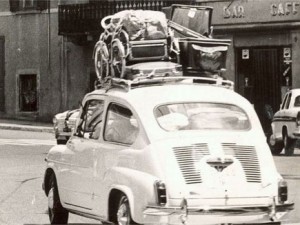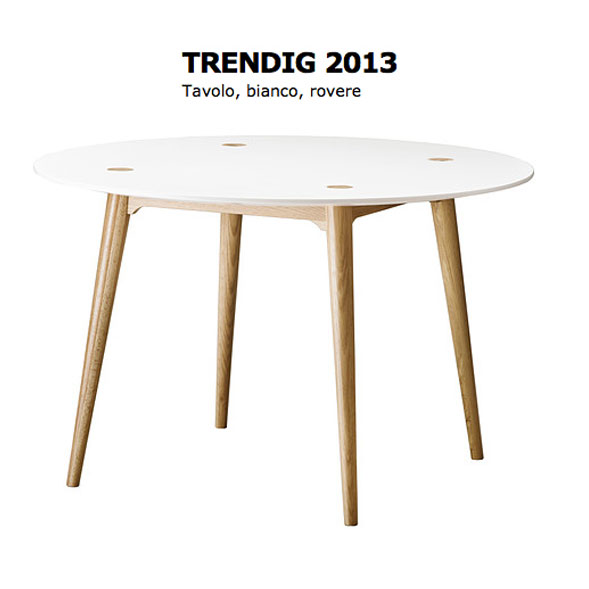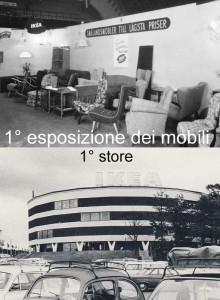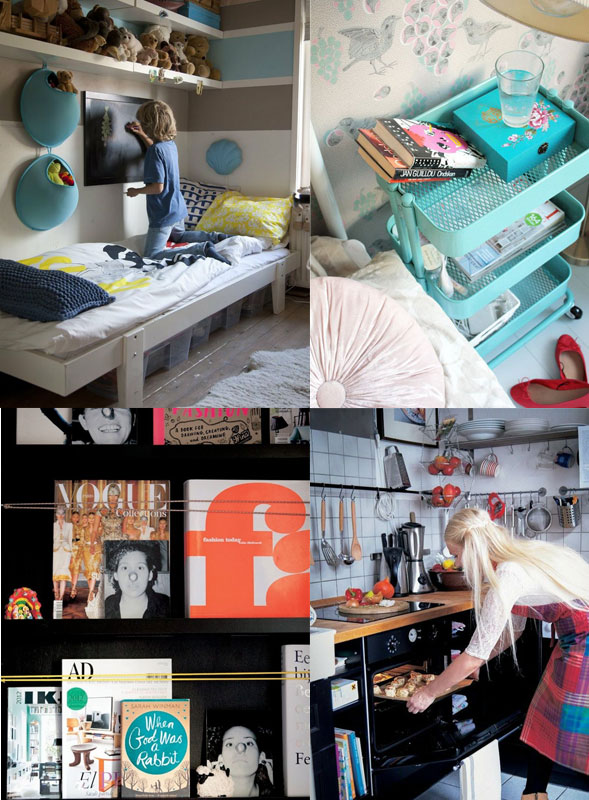

Sono stata più volte all’Ikea nelle ultime settimane e così incuriosita da tanta genialità ho cercato la storia che qui vi riporto in breve (fonte Wikipedia). Fare una “casa Ikea” è possibile e si può ottenere un risultato meraviglioso. Io ho appena comprato il tavolo della cucina, stupendo…se avete dei dubbi vi aspetto a colazione!. Come in tutti i mega store non tutto va bene e non sempre si trova la qualità necessaria affinchè le cose durino nel tempo, ma se hai un po’ di occhio e sai contestualizzare i prodotti nei tuoi spazi magari rivisitandoli ove possibile, puoi fare acquisti straordinari e ottenere un risultato incredibile. Moderno, chic, allegro e con una particolare soddisfazione per le tasche di tutti.
Il mio tavolo si chiama: TRENDIG
P.s: Il tavolo con mio marito, l’abbiamo comprato che l’Ikea stava chiudendo grazie alla sosta per polpettine con la salsa di mirtilli. Al buio e freddo nel parcheggio ci siamo accorti che eravamo due polli perchè non entrava in macchina.
Parcheggio deserto, casse chiuse…panico! Mio marito abilmente è rientrato dall’uscita per chiedere una corda.  I maghi dell’Ikea a furia di polli e di fantasiosi trasportatori, la corda la vende proprio a fianco delle casse. Da abile marinaio è riuscito a fissare sul tetto della macchina il Trendig e come due lumache siamo tornati a casa ridendo a crepapelle. Per un attimo siamo tornati all’Italia anni 50 di Alberto Sordi dove in vacanza si portavano legati come salami sul tetto della 600 mobili e valigie.
I maghi dell’Ikea a furia di polli e di fantasiosi trasportatori, la corda la vende proprio a fianco delle casse. Da abile marinaio è riuscito a fissare sul tetto della macchina il Trendig e come due lumache siamo tornati a casa ridendo a crepapelle. Per un attimo siamo tornati all’Italia anni 50 di Alberto Sordi dove in vacanza si portavano legati come salami sul tetto della 600 mobili e valigie.
Il nome IKEA, acronimo delle iniziali del suo fondatore Ingvar Kamprad e di Elmtaryd e Agunnaryd, la fattoria e il villaggio svedese di nascita, viene costituita nel 1943 come ditta di vendita per corrispondenza di articoli di uso quotidiano: penne, fiammiferi, orologi, bustine di semi e decorazioni. Kamprad, diciassettenne, decise di utilizzare la somma di denaro ricevuta dal padre come premio per lo studio, per aprire una propria attività.
Nel 1950 i mobili entrarono a fare parte dell’assortimento e nel 1951 venne realizzato il primo Catalogo: una pubblicazione di 16 pagine con illustrazioni dei vari prodotti disponibili; un segno distintivo da questo momento per l’azienda.
Nel 1953 la sede venne trasferita ad Älmhult, nel sud della Svezia, dove nel 1958 Ingvar Kamprad aprì il suo primo negozio. Da qui IKEA iniziò a specializzarsi gradualmente in mobili e complementi d’arredo sviluppando un proprio assortimento esclusivo, fornendo articoli di design a prezzi vantaggiosi e accessibili alla maggior parte della popolazione.
Nel 1965 IKEA arrivò a Stoccolma, dove il gran successo riscosso fin dal giorno dell’inaugurazione sancì definitivamente l’ingresso sul mercato in grande scala. Qui, sempre nel 1965, venne inaugurato anche un nuovo spazio di vendita, chiamato il Mercato, un ambiente fatto di piccole botteghe specializzate, come un mercatino tradizionale, che ancora oggi esiste e comprende Lampade, Cornici, Poster, Articoli per bambini, Articoli per ordinare la casa, Strumenti da Cucina, Vetro, Porcellana, Tappeti, Verde, Tessuti, Biancheria da Letto, Biancheria da Bagno.
A partire dagli anni sessanta, IKEA conobbe una forte espansione territoriale e in fatto di punti vendita, fino a raggiungere 345 negozi nel 2013.
In the last few weeks I have been to Ikea many times. I was so impressed by the great genius that I have eagerly looked for the story I am going to summarize hereunder (sourced from Wikipedia). It is possible to make an “Ikea home”, and the result is most likely to be amazing. Of late I have bought the table for my kitchen, super … any doubt? Well, come to my place for lunch then! As is the case for all megastores not everything is OK, and the quality needed for durable goods is not always available, but if you have a good eye for things and you are able to figure out what the items are going to look like once they are set in your rooms, ready for any rearrangement if necessary, well, then you will be certainly able to purchase at your best and get a wonderful goal. Modern, chic, lively and well affordable to all of us.
My table is called TRENDIG.
PS: My husband and me bought the table just at the time when IKEA was shutting down due to the break we had had for meatballs and blueberry sauce. In the cold darkness of the parking lot we did realize we had been so foolish as the table was too big to be stored in our car. Nobody in the parking lot, the store shut down… we were about to panic! My husband was wise enough to enter from the exit to ask for a rope. The brilliant people at IKEA sell ropes exactly to the side of the cash desks, considering the many foolish and bizarre transporters they have the chance to deal with. A talented sailor man, my husband was able to fasten Trendig on the car roof, so we drove back home as slow as snails, bent over with laughter. For a short flash we reverted to the Alberto Sordi-style Italy of the 50’s, where people used to carry furniture and baggage fastened on their Seicento car roof as if they were salami.
The IKEA brand, an acronym from the initial letters of its founder Ingvar Kamprad and of Elmtaryd and Agunnaryd, the farm and the Swedish village where he was born, was established in 1943 as a firm selling household items by mail ordering: pens, matches, watches, seed bags and decorations. Kamprad, a seventeen-year-old boy at the time, decided to invest the sum of money he had been given by his father as a reward for his successful educational career to start up his own enterprise.
The first IKEA catalogue, published in 1951
In 1950 furniture became part of the product gamut, and in 1951 the first Catalogue was ready: an issue made up of 16 pages featuring the pictures of the different items on tap. It was a distinctive mark for the firm from that moment onwards.
In 1953 the corporate headquarters were relocated to Älmhult, South Sweden, where Ingvar Kamprad opened his first store in 1958. From then on IKEA started to be gradually specializing in furniture and decor items, thus developing an exclusive array of goods of their own, supplying most convenient design pieces a vast clientele could afford to buy.
In 1965 IKEA landed in Stockholm where the great success they had been relishing since the very kick-off day sealed their prominent position on the large-scale market. Here, in 1965 as well, the new sales showroom was also kicked-off, named the Market, a complex made up of small specialized stores, looking like a traditional market, still existing today and comprised of Lamps, Frames, Posters, Kids’ items, Household items, Kitchen tools, Glass, Porcelain, Carpets, Green items, Fabrics, Bed linens, Bath cloths.
As from the 60’s IKEA could enjoy a remarkable territorial expansion and increase the number of their outlets which have grown as many as 345 up to 2013.







